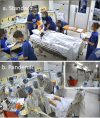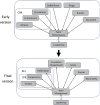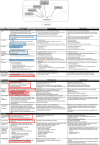Developing a learning tool for advanced life support and resuscitation: Performance Reflection Model for Resuscitation (PRM-Resus)
- PMID: 40616030
- PMCID: PMC12231619
- DOI: 10.1186/s12909-025-07509-9
Developing a learning tool for advanced life support and resuscitation: Performance Reflection Model for Resuscitation (PRM-Resus)
Abstract
Background: Acquiring proficiency in advanced life support (ALS) can pose challenges for novice learners. Simulation-based training (SBT) is widely used to address this, offering learners opportunities to practise and receive feedback during debriefing. However, existing performance tools often lack the clarity, behavioural specificity, and educational scaffolding required to support deep reflective learning. This study aimed to develop and evaluate the Performance Reflection Model for Resuscitation (PRM-Resus) and to integrate it with the ALS Team Model and structured video exemplars as a comprehensive learning package to enhance ALS training.
Methods: The study involved four phases. Phase 1 created the ALS Team Model to clarify individual roles. Phase 2 focused on co-designing PRM-Resus, using team expertise and the Team Model to create behaviourally anchored performance descriptors. In Phase 3, video scenarios were produced to represent ALS team performance at varying proficiency levels. Phase 4 evaluated the PRM-Resus through expert think-aloud studies. Qualitative content analysis was used alongside Cronbach's alpha to assess internal consistency and its use for SBT.
Results: The PRM-Resus comprises four domains-clinical skills, clinical knowledge, team management, and leadership-each defined by behavioural descriptors across three performance levels. The participating experts endorsed the tool's clarity, structure, and educational value for novice learners. Internal consistency was high (α > 0.95). When used alongside the ALS Team Model and video exemplars, PRM-Resus facilitated deeper performance analysis, which had potential for enhancing post-simulation reflection and supporting faculty development.
Conclusions: This study presents a novel, interdisciplinary framework that integrates PRM-Resus, the ALS Team Model, and video exemplars to support reflective learning in ALS simulation. Together, these tools help novice learners build a concrete understanding of effective team performance and enable educators to deliver more structured feedback. Further research should explore its impact on learner development and potential translation into improved clinical outcomes.
Keywords: Advanced life support; Interdisciplinary; Non-technical skills; Performance assessment; Simulation; Team work.
© 2025. Crown.
Conflict of interest statement
Declarations. Ethics approval and participant consent: The study protocols were approved by the relevant Human Research Ethical Committees at the Mater Hospital and Griffith University (HREC/MML/68856 and GUHREC/2020/892). Written informed consent was obtained from each participant of the study. This study is not a clinical trial and does not have a clinical trial number. Consent for publication: Informed consents for publication have been obtained from the seven participants whose photos shown in Figs. 2 and 6. Competing interests: The authors declare no competing interests.
Figures







Similar articles
-
Health professionals' experience of teamwork education in acute hospital settings: a systematic review of qualitative literature.JBI Database System Rev Implement Rep. 2016 Apr;14(4):96-137. doi: 10.11124/JBISRIR-2016-1843. JBI Database System Rev Implement Rep. 2016. PMID: 27532314
-
The educational effects of portfolios on undergraduate student learning: a Best Evidence Medical Education (BEME) systematic review. BEME Guide No. 11.Med Teach. 2009 Apr;31(4):282-98. doi: 10.1080/01421590902889897. Med Teach. 2009. PMID: 19404891
-
Faculty development initiatives designed to promote leadership in medical education. A BEME systematic review: BEME Guide No. 19.Med Teach. 2012;34(6):483-503. doi: 10.3109/0142159X.2012.680937. Med Teach. 2012. PMID: 22578043
-
Factors that impact on the use of mechanical ventilation weaning protocols in critically ill adults and children: a qualitative evidence-synthesis.Cochrane Database Syst Rev. 2016 Oct 4;10(10):CD011812. doi: 10.1002/14651858.CD011812.pub2. Cochrane Database Syst Rev. 2016. PMID: 27699783 Free PMC article.
-
A New Measure of Quantified Social Health Is Associated With Levels of Discomfort, Capability, and Mental and General Health Among Patients Seeking Musculoskeletal Specialty Care.Clin Orthop Relat Res. 2025 Apr 1;483(4):647-663. doi: 10.1097/CORR.0000000000003394. Epub 2025 Feb 5. Clin Orthop Relat Res. 2025. PMID: 39915110
References
-
- Australian and New Zealand Committee on Resuscitation. Australian and New Zealand Committee on Resuscitation Guideline 10.2 - Advanced Life Support (ALS) Training. 2024.
-
- Andersen PO, Jensen MK, Lippert A, Ostergaard D, Klausen TW. Development of a formative assessment tool for measurement of performance in multi-professional resuscitation teams. Resuscitation. 2010;81(6):703–11. 10.1016/j.resuscitation.2010.01.034. - PubMed
-
- Johnson BK. Simulation observers learn the same as participants: the evidence. Clin Simul Nurs. 2019;33:26–34. 10.1016/j.ecns.2019.04.006.
-
- Peltonen LM, Peltonen V, Salantera S, Tommila M. Development of an instrument for the evaluation of advanced life support performance. Acta Anaesthesiol Scand. 2017;61(9):1215–31. 10.1111/aas.12960. - PubMed
MeSH terms
Grants and funding
LinkOut - more resources
Full Text Sources
Miscellaneous

